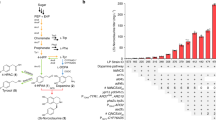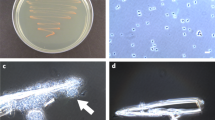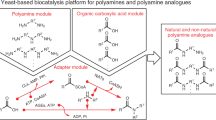Abstract
Opiates and related molecules are medically essential, but their production via field cultivation of opium poppy Papaver somniferum leads to supply inefficiencies and insecurity. As an alternative production strategy, we developed baker's yeast Saccharomyces cerevisiae as a microbial host for the transformation of opiates. Yeast strains engineered to express heterologous genes from P. somniferum and bacterium Pseudomonas putida M10 convert thebaine to codeine, morphine, hydromorphone, hydrocodone and oxycodone. We discovered a new biosynthetic branch to neopine and neomorphine, which diverted pathway flux from morphine and other target products. We optimized strain titer and specificity by titrating gene copy number, enhancing cosubstrate supply, applying a spatial engineering strategy and performing high-density fermentation, which resulted in total opioid titers up to 131 mg/l. This work is an important step toward total biosynthesis of valuable benzylisoquinoline alkaloid drug molecules and demonstrates the potential for developing a sustainable and secure yeast biomanufacturing platform for opioids.
This is a preview of subscription content, access via your institution
Access options
Subscribe to this journal
Receive 12 print issues and online access
$259.00 per year
only $21.58 per issue
Buy this article
- Purchase on Springer Link
- Instant access to full article PDF
Prices may be subject to local taxes which are calculated during checkout




Similar content being viewed by others
Accession codes
References
Bernáth, J. Poppy: the genus Papaver. (Harwood Academic Publishers, Amsterdam, the Netherlands, 1998).
International Narcotics Control Board. Narcotic Drugs: Estimated World Requirements for 2013, Statistics for 2011 (2012).
PDR Network Physicians' Desk Reference. Edn. 66. (Medical Economics Co., Montvale, NJ, 2012).
Hagel, J.M. & Facchini, P.J. Benzylisoquinoline alkaloid metabolism: a century of discovery and a brave new world. Plant Cell Physiol. 54, 647–672 (2013).
Rinner, U. & Hudlicky, T. Synthesis of morphine alkaloids and derivatives. Top. Curr. Chem. 309, 33–66 (2012).
Hagel, J.M. & Facchini, P.J. Dioxygenases catalyze the O-demethylation steps of morphine biosynthesis in opium poppy. Nat. Chem. Biol. 6, 273–275 (2010).
Larkin, P.J. et al. Increasing morphinan alkaloid production by over-expressing codeinone reductase in transgenic Papaver somniferum. Plant Biotechnol. J. 5, 26–37 (2007).
Allen, R.S. et al. RNAi-mediated replacement of morphine with the nonnarcotic alkaloid reticuline in opium poppy. Nat. Biotechnol. 22, 1559–1566 (2004).
Wijekoon, C.P. & Facchini, P.J. Systematic knockdown of morphine pathway enzymes in opium poppy using virus-induced gene silencing. Plant J. 69, 1052–1063 (2012).
Becker, J.V. et al. Metabolic engineering of Saccharomyces cerevisiae for the synthesis of the wine-related antioxidant resveratrol. FEMS Yeast Res. 4, 79–85 (2003).
Ro, D.K. et al. Production of the antimalarial drug precursor artemisinic acid in engineered yeast. Nature 440, 940–943 (2006).
Hawkins, K.M. & Smolke, C.D. Production of benzylisoquinoline alkaloids in Saccharomyces cerevisiae. Nat. Chem. Biol. 4, 564–573 (2008).
Kim, J.S. et al. Improvement of reticuline productivity from dopamine by using engineered Escherichia coli. Biosci. Biotechnol. Biochem. 77, 2166–2168 (2013).
Nakagawa, A. et al. A bacterial platform for fermentative production of plant alkaloids. Nat. Commun. 2, 326 (2011).
Nakagawa, A. et al. Bench-top fermentative production of plant benzylisoquinoline alkaloids using a bacterial platform. Bioeng. Bugs 3, 49–53 (2012).
Minami, H. et al. Microbial production of plant benzylisoquinoline alkaloids. Proc. Natl. Acad. Sci. USA 105, 7393–7398 (2008).
Siddiqui, M.S., Thodey, K., Trenchard, I. & Smolke, C.D. Advancing secondary metabolite biosynthesis in yeast with synthetic biology tools. FEMS Yeast Res. 12, 144–170 (2012).
Alcantara, J., Bird, D.A., Franceschi, V.R. & Facchini, P.J. Sanguinarine biosynthesis is associated with the endoplasmic reticulum in cultured opium poppy cells after elicitor treatment. Plant Physiol. 138, 173–183 (2005).
Bird, D.A. & Facchini, P.J. Berberine bridge enzyme, a key branch-point enzyme in benzylisoquinoline alkaloid biosynthesis, contains a vacuolar sorting determinant. Planta 213, 888–897 (2001).
Onoyovwe, A. et al. Morphine biosynthesis in opium poppy involves two cell types: sieve elements and laticifers. Plant Cell 25, 4110–4122 (2013).
Conrado, R.J. et al. DNA-guided assembly of biosynthetic pathways promotes improved catalytic efficiency. Nucleic Acids Res. 40, 1879–1889 (2012).
Delebecque, C.J., Lindner, A.B., Silver, P.A. & Aldaye, F.A. Organization of intracellular reactions with rationally designed RNA assemblies. Science 333, 470–474 (2011).
Dueber, J.E. et al. Synthetic protein scaffolds provide modular control over metabolic flux. Nat. Biotechnol. 27, 753–759 (2009).
Moon, T.S., Dueber, J.E., Shiue, E. & Prather, K.L. Use of modular, synthetic scaffolds for improved production of glucaric acid in engineered E. coli. Metab. Eng. 12, 298–305 (2010).
Dumas, B. et al. 11 beta-hydroxylase activity in recombinant yeast mitochondria. In vivo conversion of 11-deoxycortisol to hydrocortisone. Eur. J. Biochem. 238, 495–504 (1996).
Avalos, J.L., Fink, G.R. & Stephanopoulos, G. Compartmentalization of metabolic pathways in yeast mitochondria improves the production of branched-chain alcohols. Nat. Biotechnol. 31, 335–341 (2013).
Bayer, T.S. et al. Synthesis of methyl halides from biomass using engineered microbes. J. Am. Chem. Soc. 131, 6508–6515 (2009).
Farhi, M. et al. Harnessing yeast subcellular compartments for the production of plant terpenoids. Metab. Eng. 13, 474–481 (2011).
Unterlinner, B., Lenz, R. & Kutchan, T.M. Molecular cloning and functional expression of codeinone reductase: the penultimate enzyme in morphine biosynthesis in the opium poppy Papaver somniferum. Plant J. 18, 465–475 (1999).
Nielsen, B., Roe, J. & Brochmann-Hanssen, E. Oripavine - a new opium alkaloid. Planta Med. 48, 205–206 (1983).
Parker, H.I., Blaschke, G. & Rapoport, H. Biosynthetic conversion of thebaine to codeine. J. Am. Chem. Soc. 94, 1276–1282 (1972).
Bruce, N.C. et al. Microbial degradation of the morphine alkaloids: identification of morphine as an intermediate in the metabolism of morphine by Pseudomonas putida M10. Arch. Microbiol. 154, 465–470 (1990).
Bruce, N.C., Wilmot, C.J., Jordan, K.N., Stephens, L.D. & Lowe, C.R. Microbial degradation of the morphine alkaloids. Purification and characterization of morphine dehydrogenase from Pseudomonas putida M10. Biochem. J. 274, 875–880 (1991).
French, C.E. & Bruce, N.C. Purification and characterization of morphinone reductase from Pseudomonas putida M10. Biochem. J. 301, 97–103 (1994).
French, C.E. et al. Biological production of semisynthetic opiates using genetically engineered bacteria. Bio/Technology 13, 674–676 (1995).
Zhang, Q., Rich, J.O., Cotterill, I.C., Pantaleone, D.P. & Michels, P.C. 14-Hydroxylation of opiates: catalytic direct autoxidation of codeinone to 14-hydroxycodeinone. J. Am. Chem. Soc. 127, 7286–7287 (2005).
Lister, D.L., Kanungo, G., Rathbone, D.A. & Bruce, N.C. Transformations of codeine to important semisynthetic opiate derivatives by Pseudomonas putida m10. FEMS Microbiol. Lett. 181, 137–144 (1999).
Gollwitzer, J., Lenz, R., Hampp, N. & Zenk, M.H. The transformation of neopinone to codeinone in morphine biosynthesis proceeds non-enzymatically. Tetrahedr. Lett. 34, 5703–5706 (1993).
Lenz, R. & Zenk, M.H. Purification and properties of codeinone reductase (NADPH) from Papaver somniferum cell cultures and differentiated plants. Eur. J. Biochem. 233, 132–139 (1995).
Homeyer, A.H. & Shilling, W.L. Isolation and purification of neopine. J. Org. Chem. 12, 356–358 (1947).
Al-Amri, A.M., Smith, R.M. & El-Haj, B.M. The GC-MS detection and characterization of neopine resulting from opium use and codeine metabolism and its potential as an opiate-product-use marker. Anal. Bioanal. Chem. 382, 830–835 (2005).
Farrow, S.C. & Facchini, P.J. Dioxygenases catalyze O-demethylation and O,O-demethylenation with widespread roles in benzylisoquinoline alkaloid metabolism in opium poppy. J. Biol. Chem. 288, 28997–29012 (2013).
Liscombe, D.K., Ziegler, J., Schmidt, J., Ammer, C. & Facchini, P.J. Targeted metabolite and transcript profiling for elucidating enzyme function: isolation of novel N-methyltransferases from three benzylisoquinoline alkaloid-producing species. Plant J. 60, 729–743 (2009).
Gueldener, U., Heinisch, J., Koehler, G.J., Voss, D. & Hegemann, J.H. A second set of loxP marker cassettes for Cre-mediated multiple gene knockouts in budding yeast. Nucleic Acids Res. 30, e23 (2002).
Guldener, U., Heck, S., Fielder, T., Beinhauer, J. & Hegemann, J.H. A new efficient gene disruption cassette for repeated use in budding yeast. Nucleic Acids Res. 24, 2519–2524 (1996).
Alberti, S., Gitler, A.D. & Lindquist, S. A suite of Gateway cloning vectors for high-throughput genetic analysis in Saccharomyces cerevisiae. Yeast 24, 913–919 (2007).
Parlati, F., Dominguez, M., Bergeron, J.J. & Thomas, D.Y. Saccharomyces cerevisiae CNE1 encodes an endoplasmic reticulum (ER) membrane protein with sequence similarity to calnexin and calreticulin and functions as a constituent of the ER quality control apparatus. J. Biol. Chem. 270, 244–253 (1995).
Bevis, B.J., Hammond, A.T., Reinke, C.A. & Glick, B.S. De novo formation of transitional ER sites and Golgi structures in Pichia pastoris. Nat. Cell Biol. 4, 750–756 (2002).
Meuzelaar, G.J., Woudenberg, R.H., Sinnema, A. & Maat, L. Synthesis of neopine and its 5β- and 7-substituted derivatives (chemistry of opium alkaloids, part XL). Recl. Trav. Chim. Pays Bas 112, 573–577 (1993).
Raith, K. et al. Electrospray tandem mass spectrometric investigations of morphinans. J. Am. Soc. Mass Spectrom. 14, 1262–1269 (2003).
Acknowledgements
We thank F.J. Lu for contributions to strain construction and testing; Noramco for the gift of standards codeinone, dihydrocodeine, oripavine, morphinone and 14-hydroxycodeine; members of the Stanford Cell Sciences Imaging Facility for providng fluorescence microscopy access (Leica SP5 NIH grant SIG number: 1S10RR02557401) and training; members of the Stanford Chemistry NMR Facility and S. Lynch for instrument access and training; J. Li for helpful discussions and sharing equipment for compound isolation; D. Endy, M. McKeague, I. Trenchard, A.L. Chang and Y.-H. Wang for valuable feedback in the preparation of the manuscript. This work was supported by US National Institutes of Health (grant to C.D.S., DP1OD009329), the National Science Foundation (grant to C.D.S., CBET-1066100; fellowship to S.G.), the Bill and Melinda Gates Foundation (grant to C.D.S., OPP1058690), the New Zealand Foundation for Research, Science and Technology (fellowship to K.T., SFRD0901) and Stanford University (fellowship to S.G.).
Author information
Authors and Affiliations
Contributions
K.T. and C.D.S. conceived of the project, designed the experiments, analyzed the results and wrote the manuscript. K.T. constructed and tested the strains. S.G. performed NMR spectroscopy and in vitro assays, and prepared parts of the manuscript.
Corresponding author
Ethics declarations
Competing interests
C.D.S., K.T. and S.G. have filed a patent application (US application no. 14/211,611) covering yeast strains developed for the production of opioids and other benzylisoquinoline alkaloids.
Supplementary information
Supplementary Text and Figures
Supplementary Results, Supplementary Figures 1–9 and Supplementary Tables 1–5. (PDF 2153 kb)
Rights and permissions
About this article
Cite this article
Thodey, K., Galanie, S. & Smolke, C. A microbial biomanufacturing platform for natural and semisynthetic opioids. Nat Chem Biol 10, 837–844 (2014). https://doi.org/10.1038/nchembio.1613
Received:
Accepted:
Published:
Issue Date:
DOI: https://doi.org/10.1038/nchembio.1613
This article is cited by
-
Biosensor and machine learning-aided engineering of an amaryllidaceae enzyme
Nature Communications (2024)
-
Metabolic engineering of Rhodotorula toruloides for resveratrol production
Microbial Cell Factories (2022)
-
A microbial supply chain for production of the anti-cancer drug vinblastine
Nature (2022)
-
Engineering Saccharomyces cerevisiae to produce plant benzylisoquinoline alkaloids
aBIOTECH (2021)
-
Broadening the scope of biocatalytic C–C bond formation
Nature Reviews Chemistry (2020)



